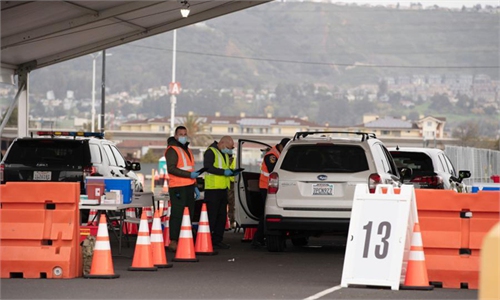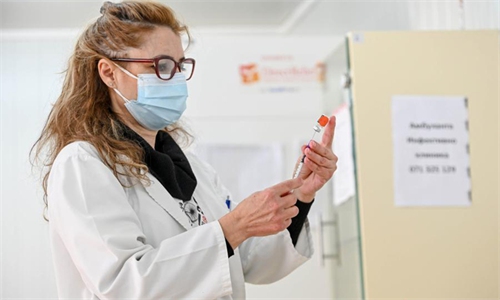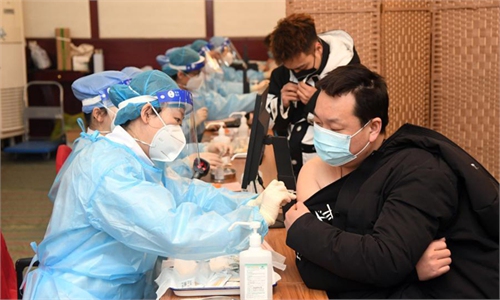Challenges on inoculation and anti-epidemic measures remain ahead as US COVID-19 deaths near 500,000

People register with National Guard members outside the mass vaccination site at Yankee Stadium in the Bronx borough of New York, the United States, Feb. 5, 2021. Photo: Xinhua
Despite the number of COVID-19 cases in the US declined in a fifth week in a row, the country still faces a dark milestone as it was poised to reach 500,000 deaths with President Joe Biden reportedly planning to honour the lives lost on Tuesday.
Chinese experts said the recent decline in COVID-19 cases shows the situation in the US has improved, which is related to the officials' scramble to inoculate the population as well as the strengthened anti-epidemic measures under the new administration.
However, challenges remain ahead as there are still about one third of the population who are opposed to be vaccinated and many people are reluctant to support the anti-epidemic measures, as well as the extreme weather that has hindered the vaccine supplies in some areas.
It has been nearly a year since the COVID-19 pandemic plagued the country, bringing with it a huge economic crisis. The New York Times said on Sunday that the loss of half a million people means that more Americans have perished from COVID-19 than on the battlefields of World War I, World War II and the Vietnam War combined.
It took less than five weeks for the US to go from 400,000 dead to 500,000. The number of fatalities doubles that of Brazil, the second ranking in the world.
"The milestone comes at a hopeful moment: new virus cases are down sharply, deaths are slowing, and vaccines are steadily being administered. But there is concern about emerging variants of the virus, and it may be months before the pandemic is contained," said the report.
The virus has reached every corner of the US, devastating dense cities and rural counties alike. By now, about one in 670 Americans has died of it, according to the report.
Liang Manchun, associate research fellow at the Institute for Public Safety Research of Tsinghua University, predicted that the situation in the US will see a fundamental improvement next year.
Dr. Anthony Fauci, the nation's top infectious disease specialist, told CNN on Sunday that it is "possible" Americans will still need to wear masks in 2022 to protect against the coronavirus, even as the US may reach "a significant degree of normality" by the end of this year.
Judging from the increasing vaccine supply, it is possible that the US could reach 60 to 70 percent of inoculation rate, which can put the new confirmed cases into an acceptable range. The country might be entering a new stage of relative control of the pandemic, Tao Lina, a Shanghai based vaccine expert, told the Global Times on Monday.
According to a new survey from Gallup, Americans' willingness to receive COVID-19 vaccines climbs from a low of 50 percent in September 2020 to 65 percent in December. The survey shows now an all-time high of 71 percent who are willing to get vaccinated.
But what remains a problem is the high rate of troops turning the vaccine down. The rejection numbers are occurring in the top categories that the Pentagon wants vaccinated- strategic forces, health care workers, those deploying and the most vulnerable- according to local media USNI News.
The report said the main reason for immediate concern was the emergence of COVID-19 variants that are affecting different age groups and in new ways.
As of February 18, the US Centers for Disease Control and Prevention reported that 41 million first doses were administered and more than 16 million people have been fully vaccinated in the US.
More than 205 million doses of the vaccines have been administered across 92 countries globally, according to data collected by Bloomberg. The latest rate was roughly 6.44 million doses a day.
Chinese experts pointed out that the major challenge ahead is the manufacturing and delivering the doses to the greater population.
Media reports showed the rate of vaccinations in the US fell last week after a winter storm blew through much of the country. The bad weather delayed shipments of vaccine supplies and more than 2,000 vaccine sites were in areas with power outages.




